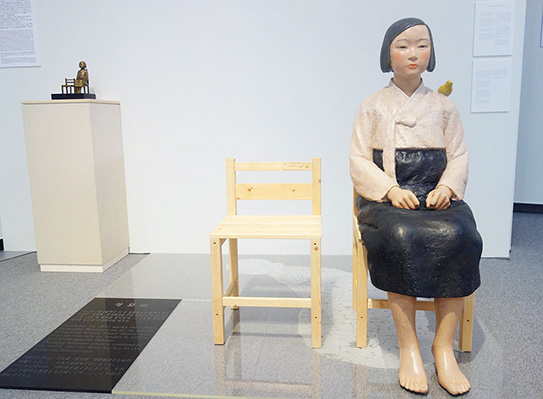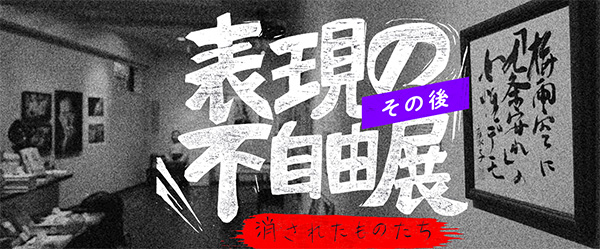'평화의 소녀상' 폐쇄 아이치 트리엔날레 작가 85명 항의 성명 발표

STATEMENT BY THE ARTISTS OF AICHI TRIENNALE 2019 ON THE CLOSURE OF AFTER “FREEDOM OF EXPRESSION?”
We the undersigned are participating artists in Aichi Triennale 2019. We here express our thoughts on the closure of the exhibit After “Freedom of Expression?”, a section of the Triennale featuring artworks that have experienced various forms of censorship at public art institutions across Japan.
As chosen by artistic director Daisuke Tsuda, the theme of Aichi Triennale 2019 is “Taming Y/Our Passion.” In his statement on the exhibition concept, Tsuda writes:
"Many concerns are shared around the world today, including anxieties related to the increase in terrorism, cutbacks in hiring domestic workers, crime, and making ends meet. Feelings of aversion towards refugees and immigrants have risen to unprecedented heights in the United States and Europe. The United Kingdom voted to leave the EU in 2016. Donald Trump was voted president of the United States under the platform of “America First.” Xenophobic voices have become emboldened here in Japan as well. At the source is anxiety—the anxiety of an uncertain future, and the anxiety of feeling unsafe and vulnerable to danger."
Many of us feel anxious about the strong displays of emotion roiling Japan today. Irrespective of its being directed at a single work or section of the exhibition, we have grave concerns about the occurrence of political intervention into the Triennale, as well as threats of violence against the exhibition and those involved in it. It is a fact that the exhibition received hundreds of intimidating phone calls after the opening of the Triennale, as well as a fax warning of an attack on the venue using gasoline and fire—recalling the July 18 arson attack on an animation studio in Kyoto that has claimed at least thirty-five lives to date. We are alarmed by the possibility of any harm coming to the people watching over our works during the exhibition period, and will do everything in our power to resist such terroristic threats and intimidation. We believe that all precautions must be taken to ensure the mental and physical safety of the exhibition staff and visitors.
We insist that After “Freedom of Expression?” should remain on view on that condition. Normally an exhibition space is meant to be an open, public site, but the closure of the exhibit just three days after the Triennale opening has robbed people of the opportunity to see the artworks and foreclosed any active discussion of them. Moreover, it has shut down the diversity of responses, ranging from feelings of anger to sorrow, that viewers might have had in front of the artworks. We strongly object to any violent intervention by politicians into exhibits, screenings, and performances at art institutions, and the kinds of menacing acts and intimidation that drove the Triennale to close After “Freedom of Expression?” as an emergency measure.
We practice art not to suppress or divide people, but to find different ways of creating solidarity among them, and to pursue the possibilities for free thinking beyond political beliefs. We strive to be creative in the face of uncertainty. Through the production of sculptures, through texts, paintings, performances, music, reenactments, psychomagic, films and videos, and by means of new media technology, by collaborating, and by seeking out new routes and detours, we artists have tried to create a place in the Triennale where, if only temporarily, people’s love and compassion, anger and sadness, and even their murderous feelings can be imaginatively inverted and overturned.
What we seek is a patient process for reaching deeper understanding—the opposite of violent interventions. What we seek is a discussion that is open to all people and respects individual opinions and conditions, and a Triennale that is capable of realizing such a discussion.
We request the following: (1) the immediate restoration of the Aichi Triennale 2019’s autonomy from political pressure and intimidation; (2) the continuation of the exhibition under the assurance of safety for all its staff and visitors; and (3) the establishment of a platform for free and vigorous discussion that is open to all, including the participating artists.
It is our conviction that the first principle of any creative endeavor is thinking about and coming up with new solutions together.
August 6, 2019
72 Participating Artists of Aichi Triennale 2019
artiststatementaichi2019@gmail.com
List of Artists (August 6, 2019)
Aoki Miku
BeBe(Shinkazoku)
Candice Breitz
James Bridle
Tania Bruguera
Miriam Cahn
Pia Camil
Chim↑Pom
Heather Dewey Hagborg
dividual inc.
exonemo
Echigo Masashi
Endo Mikiko
Hikaru Fujii
Fujiwara Aoi
Dora García
Ge Yulu
Hanzaka Yui (Shinkazoku)
Hirose Nanako
Hoshiwowa Yumeka (Shinkazoku)
Ichihara Satoko
Imamura Yohei
Imazu Kei
Ishiba Ayako
Gabin Ito
Iwasaki Takahiro
Regina José Galindo
Meiro Koizumi
Komanbe (Shinkazoku)
Komori Haruka
Kuwakubo Ryota
Kyun-chome
Leung Chi Wo + Sara Wong
Lim Minouk 임민욱
Jason Maling
Amanda Martinez
Claudia Martinez Garay
Masumoto Yoshiko
Mónica Mayer
Mayumi (Shinkazoku)
Miura Motoi
Miyata Nana (Shinkazoku)
Nagahata Koji
Nagata Kosuke
Ohashi Ai
Okamoto Mitsuhiro
One-phrase・Politics(Shinkazoku)
Oura Nobuyuki
Oyama Natsuko (Shinkazoku)
Park Chan-kyong 박찬경
Sawada Hana
Yoshio Shirakawa
Shimada Yoshiko
Studio Drift
Suge Syunichi
Takamine Tadasu
Akira Takayama
Koki Tanaka
Javier Téllez
TM(Shinkazoku)
Toda Hikaru
Tomita Katsuya
Tomotoshi
Tsuda Michiko
Usui Yui
Wada Yuina (Shinkazoku)
Washio Tomoyuki
Anna Witt
Yuan Goang-Ming
Yumisashi Kanji
Yoshida Chie (Shinkazoku)
Yoshigai Nao
Added 4pm, August 6, 2019 (total 83 artists)
Ahn Sehong
Jetse Batelaan
Fujie Tami
Ho Tzu Nyen
Kim Eun-sung 김은성
Kim Seo-kyung 김서경
Mannequin Flash Mob
Reynier Leyva Novo
Pangrok Sulap
U-Zaan
Katarina Zdjelar
Added 8am, August 8, 2019 (total 85 artists)
Nature Theater of Oklahoma
Milo Rau





 K-Artists (3) 탁순애 Soonae Tark: Color, Energy, Balance & Ha...
K-Artists (3) 탁순애 Soonae Tark: Color, Energy, Balance & Ha...
 K-Artists (2) 배소현 SoHyun Bae: 혼란 속의 침묵, 한가닥 빛을 ...
K-Artists (2) 배소현 SoHyun Bae: 혼란 속의 침묵, 한가닥 빛을 ...

